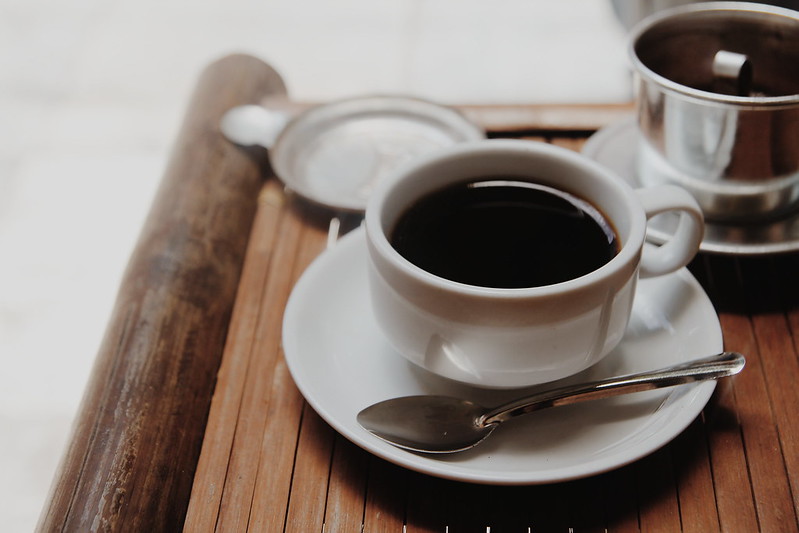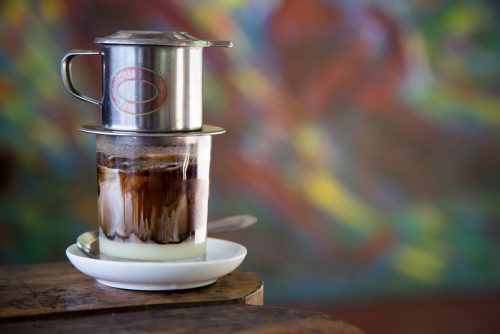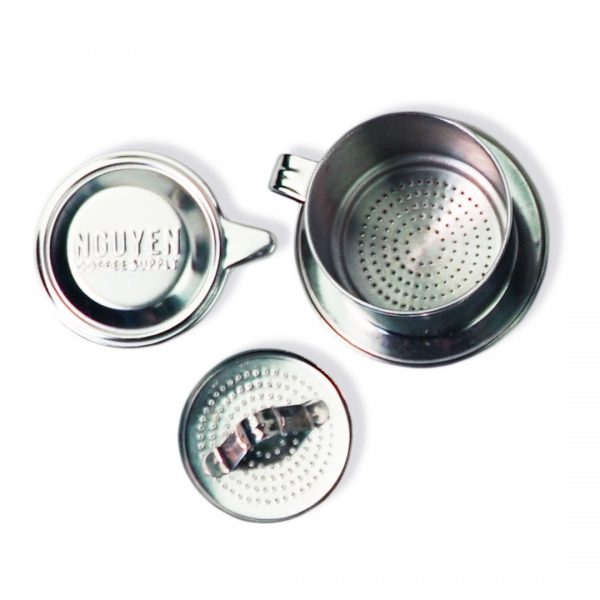A Guide On Vietnamese Coffee – Origin and Recipe

Vietnam and coffee have a long relationship. Today Vietnam is the second largest coffee producer in the world, and the first for Robusta coffee. But back before the colonial times, coffee was not well known at all.
The French introduced coffee cultivation and the drinking of it based on their taste: dark, strong and with a heavy body. At the same time, adding milk to it was customary for the French and they kept brewing their cafe au lait in Vietnam too.
But because of the tropical environment, fresh milk would go sour quickly, posing an obstacle to the easy consumption of it along with coffee. Condensed milk was then first imported and then locally produced. This is a type of milk from which most water, roughly 60% of the total, is removed.
Denser than normal milk, it also lasts for months unopened, and for quite a few days after opening. It is ideal for very hot climates as it gives consumers more time to drink it.
From the coffee grown locally and the condensed milk, the Vietnamese coffee was born. This coffee drink is a mix of a dark roasted coffee with the addition of a bit of condensed milk, making it a nice contraposition of strong, bitter coffee and sweet, thick, milk. Vietnamese coffee is a coffee of stark contrast.
Equipment and Ingredients
But how is it made? It is not simply some condensed milk added to coffee, but it has a specific way to be prepared and specific equipment. It cannot be reproduced with the usual coffee equipment that most homes already possess.
True Vietnamese coffee needs a specific cup filter/brewer known as phin. It is a small brewer, made of a filter and a small lid. It is often made of aluminium, and is large enough to comfortably sit atop a coffee cup. It can contain enough coffee grounds for a single serve of Vietnamese coffee. Nowadays outside of Vietnam it is easily found in ethnic stores, serving the East Asian communities around the world. It shouldn’t be too hard to find one nearby you.
Once you have your phin, a good, strong, French roast coffee is needed. Typically, these coffee have both Robusta and Arabica in it, and considering that most of the coffee production in Vietnam is Robusta, it is appropriate to choose a good Robusta-based blend for a true Vietnamese coffee. Go for full Arabica if you prefer, as long as it is an intense French roast coffee though. And, last but not least, a few teaspoons of condensed milk.
How To Make Vietnamese Coffee
When all the ingredients are readied, preheat the metal filter and the cup below it by pouring a bit of boiling water through it. Discard this water.
Add about 1 tablespoon of coffee grounds in the filter. More can be added, if you prefer an even more intense experience but be aware of not using too much and clog the filter.
Twist the filter, gently, until it starts to have some resistance. That will lock it, making it ready for the brewing. Place the inside filter on top of the grounds and press down lightly until you feel a gentle crunch.
If there’s a screw, use it to tighten the filter, always gently. Don’t press too strong, as that will compress the grounds too much, making brewing hard or even impossible.
Then add condensed milk to the cup or glass where you want to drink your Vietnamese coffee from. The amount is variable, according to your taste. It may be better at first to add the milk after the coffee is brewed, to better gauge the quantity but the original recipe calls for adding it before. A few teaspoons should be enough.
After the milk is in the cup and the phin brewer is over it, it’s finally time to brew the coffee. Pour about 1 oz (30ml) of boiling water and let the coffee bloom for 3-5 minutes. Do not stir.
Next, add the rest of the boiling water (7 oz/200ml or less if you want it more concentrate), and put the lid on the brewer. The water will start dripping down in the cup, over the condensed milk.
Let it drip for as long as it is needed. The whole brewing should take between 8 and 10 minutes. Allow it to complete before touching the cup.
Before drinking, stir the condensed milk so it will merge with the coffee and enjoy your hot Vietnamese coffee!

Being Vietnam a hot climate country, it is only natural that a cold version of its coffee exists. Iced Vietnamese coffee is popular and delicious, other than done in exactly the same way as the hot one. Follow the instructions above and then simply add ice, or pour the brewed coffee with the condensed milk in a glass with ice cubes, and allow a few seconds for it to cool down. This way you can enjoy Vietnamese coffee on torrid days too, as a true Vietnamese.
In Conclusion
The peculiarity of Vietnamese coffee, in contrast with all other types of coffee drinks, is twofold: it needs condensed milk instead of normal milk and uses a filter brewer that creates quite concentrated coffee, unlike any other coffee dripper.
Thus Vietnamese coffee doesn’t use neither normally brewed coffee, as the phin will make a concentrated type of coffee, nor classic milk. Some coffee drinks implement either condensed milk (or cream) or a very concentrated coffee, but not both in the same recipe.
The final taste and composition of a Vietnamese coffee is thus unique, born out of the union of a concentrated coffee, with strong, intense and bold qualities, and a dense and sweet milk, as condensed is. It is both bitter and sweet, dense and heavy in the mouth.
It is the perfect merge of the French tradition of cafè au lait, roasted very dark, with the local tradition and necessities of the tropical climate. Drank either hot, as normally done in mornings in Vietnam, or cold, as it is more customary during afternoons, will give you an original experience. A perfect marriage of two coffee cultures.

